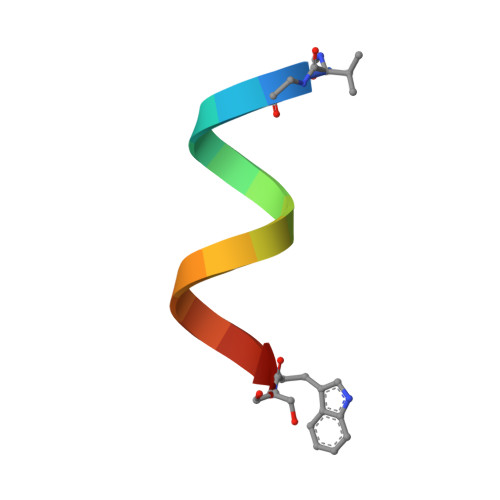Structure of Gramicidin D-Rbcl Complex at Atomic Resolution from Low-Temperature Synchrotron Data: Interactions of Double-Stranded Gramicidin Channel Contents and Cations with Channel Wall
Glowka, M.L., Olczak, A., Bojarska, J., Szczesio, M., Duax, W.L., Burkhart, B.M., Pangborn, W.A., Langs, D.A., Wawrzak, Z.(2005) Acta Crystallogr D Biol Crystallogr 61: 433
- PubMed: 15805598
- DOI: https://doi.org/10.1107/S0907444905000399
- Primary Citation of Related Structures:
1W5U - PubMed Abstract:
Gramicidin D (gD) is a naturally occurring ionophoric antibiotic that forms membrane channels specific for monovalent cations. The crystal structure of the RbCl complex of gD has been determined at 1.14 A resolution from low-temperature (100 K) synchrotron-radiation data with a final R of 16%. The structure was refined with anisotropic temperature factors for all non-H atoms and with partial occupancies for many of them. The asymmetric unit in the crystal contains four crystallographically independent molecules that form two right-handed antiparallel double-stranded dimers. There are seven distinct rubidium-binding sites in each dimeric channel. The occupancy factors of Rb cations are between 0.11 and 0.35 and the total ion contents of the two crystallographically independent channels are 1.59 and 1.22 ions, respectively. Although each channel is 'chemically symmetrical', the side-chain conformations, the distributions of rubidium cations and their binding sites in the two independent channels are not. Cations are 'coordinated' by delocalized pi-electrons of three to five carbonyl groups that together with peptide backbone chains form the gramicidin channel walls. The water:cation ratio in the channel interior is four or five:one, and five or six waters separate Rb cations during their passage through the channel.
Organizational Affiliation:
Institute of General and Ecological Chemistry, Technical University, ?¨®d?, Poland. marekglo@p.lodz.pl



















